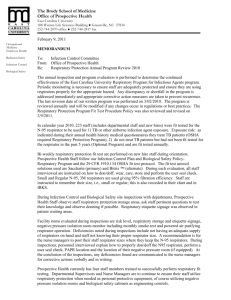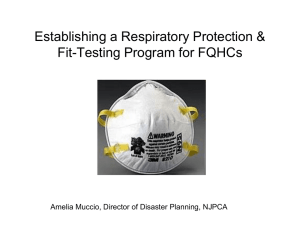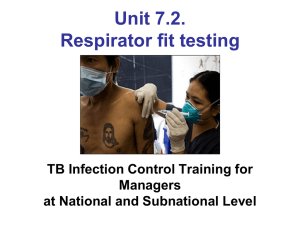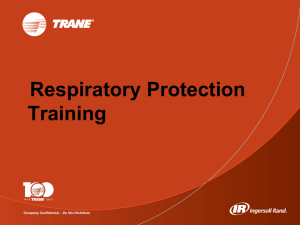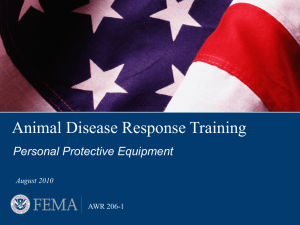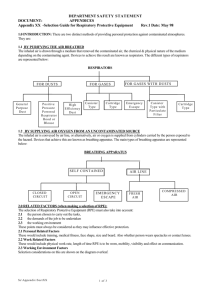Section TBA - Respiratory Protection Program
advertisement
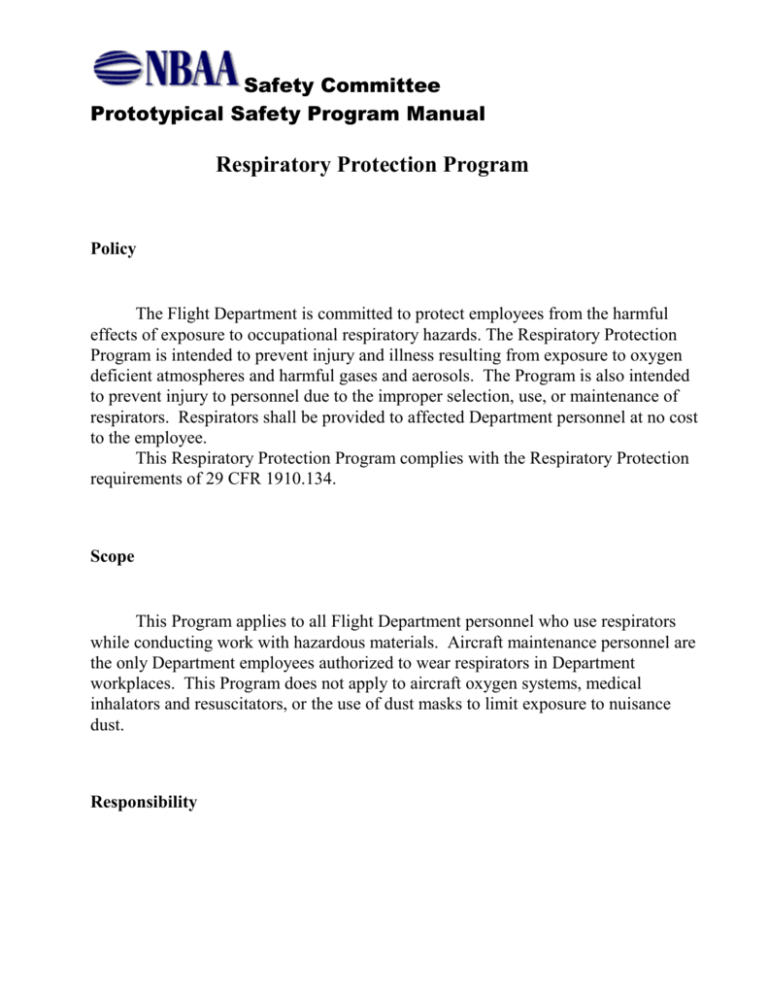
Safety Committee Prototypical Safety Program Manual Respiratory Protection Program Policy The Flight Department is committed to protect employees from the harmful effects of exposure to occupational respiratory hazards. The Respiratory Protection Program is intended to prevent injury and illness resulting from exposure to oxygen deficient atmospheres and harmful gases and aerosols. The Program is also intended to prevent injury to personnel due to the improper selection, use, or maintenance of respirators. Respirators shall be provided to affected Department personnel at no cost to the employee. This Respiratory Protection Program complies with the Respiratory Protection requirements of 29 CFR 1910.134. Scope This Program applies to all Flight Department personnel who use respirators while conducting work with hazardous materials. Aircraft maintenance personnel are the only Department employees authorized to wear respirators in Department workplaces. This Program does not apply to aircraft oxygen systems, medical inhalators and resuscitators, or the use of dust masks to limit exposure to nuisance dust. Responsibility Safety Committee Prototypical Safety Program Manual The Safety Manager/Officer is responsible for reviewing this program annually to ensure effectiveness and compliance with regulatory requirements. Periodic evaluation shall be made during Compliance Assessments. The Safety Manager/Officer is responsible for identifying the proper class of respirator, if any, required during exposure to any chemical on each facility’s Hazardous Chemical List under anticipated use conditions. Any chemical posing a respiratory hazard, as indicated on the Material Safety Data Sheet, shall not be used by Department personnel unless a determination has been made by the Safety Manager/Officer as to the appropriate form of respiratory protection. Proper selection of respirators shall be made according to the guidance of American National Standard Practices for Respiratory Protection Z88.2 - (latest edition). The [position title] is responsible for ensuring that all base maintenance personnel are knowledgeable of the facility’s respiratory protection requirements and for ensuring that respirators are selected, inspected, used, and maintained in accordance with this Program. Facility Safety Manager/Officer is responsible for maintenance of fit testing records. It is the responsibility of each employee to be aware of the respiratory protection requirements of their work areas. Employees are responsible for wearing the appropriate respiratory equipment according to proper instructions and for maintaining the equipment in a clean and operable condition. Training Each user of a respirator covered under this section, and his/her immediate supervisor, shall be trained in the proper use of respirators and their limitations. Affected personnel will be properly instructed in respirator selection, use and maintenance. Both supervisors and affected maintenance technicians will be instructed by competent and experienced persons. Training shall provide personnel the opportunity to handle the respirator, have it fitted properly, test its facepiece to face seal, wear it in normal air for a long familiarity period, and to wear it in a test atmosphere. Safety Committee Prototypical Safety Program Manual Training frequency and specific topics to be covered during training are listed in the training section of this Manual. Respirator Selection The prevention of atmospheric contamination shall be accomplished as far as feasible by engineering control measures, such as enclosing or confining the contaminant-producing operation, exhausting the contaminant, or substituting with less toxic materials. Respirators shall be utilized where engineering controls to isolate the contaminated atmosphere from the employee are impossible, impractical, or insufficient, while controls are being installed, and during clean up operations. Respirators shall be selected based upon the atmospheric hazards to which the worker is exposed. Only respirators approved by the Mine Safety and Health Administration and the National Institute for Occupational Safety and Health (MSHA/NIOSH) shall be selected and used. Respirators which have not received these approvals shall not be used by Department personnel at work and shall not be maintained in the facility. Where practicable, respirators will be assigned to individual workers for their exclusive use. Appendix I of this Section is intended as a guide to the considerations used in the proper selection of classes of respiratory protection. Respirator Fit Testing Only personnel trained in the proper use of respirators, in accordance with the training section of this Manual, are authorized to utilize respiratory protection in Department workplaces. Each authorized user shall be fit tested in accordance with the requirements of the OSHA Respiratory Protection Standard. Personnel unable to achieve an acceptable result during fit testing shall not be permitted to use a tightfitting respirator. A fit test shall be conducted at least once every 12 months for each Safety Committee Prototypical Safety Program Manual wearer of a tight-fitting respirator. A fit test shall be repeated when a person has a condition which may interfere with facepiece sealing, such as significant change in body weight (10% or more), significant scarring in the area of the faceseal, dental changes, reconstructive or cosmetic surgery, or any other condition that may affect the fit of the facepiece seal. Initial fit testing shall be performed during employee respirator training for all types of respirators to be used. Fit testing shall include instruction on negative and positive pressure tests, as appropriate for the specific repirator. Fit test evaluation shall be made using recognized qualitative fit testing procedures and solutions by a person trained to perform fit testing. Fit testing shall be performed while wearing protective equipment, such as spectacles, goggles, face shield, or helmet, that will be worn during work activities and could interfere with the fit. Respirator users shall be issued prescription spectacle kits if they are required to wear a full face respirator and use prescription glasses. Employees shall not use, or be fit tested for, tight fitting respirators that require a seal for effective performance when facial hair or other conditions prevent the seal. In addition to a beard, other conditions which may prevent a seal include absence of normally worn dentures, facial configuration, facial scars, or eyewear that projects under the facepiece seal. Fit testing shall include a series of exercises such as normal breathing, deep breathing, turning head from side to side, nodding up and down, talking, or other activities that may simulate actual working conditions, to ensure a proper seal at all times. Each person being fit tested shall be given the opportunity to test a variety of respirator models providing suitable protection from an assortment of at least three sizes for each type of facepiece and from at least two different manufacturers. A facepiece seal check shall be performed by the employee each time a tightfitting respirator is worn, using the techniques demonstrated during the respirator training. (See Appendix II in this Section - Donning the Respirator.) A record of fit testing shall be maintained by the facility Safety Manager/Officer. Each employee currently authorized to wear respiratory protection shall have a record of fit testing, performed during the previous 12 months, on file. Respirator fit test records shall include the following information: Safety Committee Prototypical Safety Program Manual written standard operating procedures for the respirator fit testing program including pass/fail criteria; type of respirator fit test(s) used, including specific fit test protocol; type of respirator fit test instrumentation and equipment used; instrument and equipment calibration, maintenance, and repair, where applicable; name or identification of the test operator; specific make, model, and size of the exact respiratory protective device tested; date of test; results of respirator fitting tests, including: fit factor based upon quantitative fit test(s), as applicable, success or failure to obtain a satisfactory fit based upon qualitative fit test(s), as applicable, and any special considerations or difficulties in wearing (contact lenses or glasses worn, dentures, forehead scars, etc.) Respirator fit test records supplied by vendors are adequate as long as the above information is included at a minimum. Medical Evaluation The medical certification requirements of this paragraph apply only to personnel required to use respiratory protection for more than five hours during any work week. The [position title] is responsible for ensuring that any maintenance technician required to utilize respiratory protection for more than five hours during any work week have a current written medical certification available at the facility. Employees will not be assigned to tasks requiring the use of respirators unless they are physically able to perform the work while using the respirator. Employees shall not be provided or use respiratory protection without prior written certification stating the employee is physically able to use respiratory protection. Safety Committee Prototypical Safety Program Manual Determination of medical certification for respirator use shall be made by the Company Medical Officer, a certified physician, or other qualified medical personnel under the direction of a certified physician. Medical recertification shall be performed annually and at any time the employee experiences unusual difficulty breathing while being fitted for or while using a respirator. Parameters to be included in the medical evaluation shall be determined by the Company Medical Officer and will include consideration of: Make and model of the respirator under consideration for use, Anticipated duration of respirator usage, Activities which will be performed during respirator use, and Type of potential exposure hazard. Personnel identified with an impaired sense of smell shall be prohibited from the use of air purifying respirators and shall not be permitted to use air supplied respirators unless quantitative fit testing has been performed. A current copy of the medical certification form shall be maintained by the Safety Manager/Officer. Respirator Use and Care Employees must be aware that respiratory equipment does not eliminate the hazard. If the respiratory equipment fails, over-exposure may occur. To reduce the possibility of failure, respirator equipment must fit properly and be maintained in a clean and serviceable condition. Respirators shall be regularly cleaned and disinfected. Those respirators issued for the exclusive use of one employee will be cleaned after each use, or more often, if necessary. Respirators used by more than one employee must be thoroughly cleaned and disinfected after each use. Manufacturer’s recommendations concerning cleansing and disinfecting will be adhered to. Safety Committee Prototypical Safety Program Manual Respirators shall be inspected for wear and damage before and after each use by the wearer. A written record of respirator inspections shall be maintained in the respirator case or storage area. The inspection record must include the inspected items, user’s initials, and date performed. Respirator inspection shall include a check of the tightness of connections and the condition of the facepiece, headbands, valves, connecting tube, and canisters. Rubber or elastomer parts shall be inspected for pliability and signs of deterioration. Stretching and manipulating rubber or elastomer parts with a massaging action will keep them pliable and flexible and prevent them from taking a set during storage. Worn or deteriorated parts will be replaced. Replacement of worn or damaged parts shall only be made with manufacturer designated replacement parts. Only trained and experienced personnel are authorized to replace respirator parts. No attempt shall be made to replace components or to make adjustments or repairs beyond the manufacturer’s recommendations. Reducing or admission valves or regulators shall be returned to the manufacturer or to a trained technician for adjustment or repair. No employees shall be permitted to wear tight-fitting respirators where facial hair or other conditions exist which prevents a proper facepiece to face seal. Such conditions may be a growth of beard, sideburns, a skull cap that projects under the facepiece, or temple pieces on glasses. To assure proper protection, the facepiece fit will be checked by the wearer each time the wearer dons a respirator. This will be accomplished by following the manufacturer’s fitting instructions or the procedure outlined in Appendix II of this section. Personnel shall not wear hard, nonpermeable contact lenses while wearing full facepiece respirators. Contaminants entering the facepiece may cause serious and incapacitating eye irritation. The use of rigid, gas permeable or soft (hydrophilic) contact lenses is acceptable for any type of respirator. Personnel who cannot comfortably wear contact lenses in everyday, non-work situations shall not wear contact lenses while using respiratory protection. Air purifying respirators may only be utilized under the following conditions: The hazardous compound has been identified and quantified, The compound possesses adequate warning properties (i.e., chemical taste, smell, or irritation prior to PEL/REL/TLV), and Safety Committee Prototypical Safety Program Manual There is at least 19.5% oxygen present. The acceptability of using air purifying respirators over other classes of respirators to remove chemical containants is dependent upon the user’s ability to detect the warning properties (i.e., smell, taste, irritation) of the contaminant(s) in question. Affected personnel are required to be aware of these warning properties, as described in Material Safety Data Sheets, of any chemical posing a respiratory hazard prior to the use of that chemical. When the applicable warning properties are detected, or when breathing becomes difficult, the work area should be vacated immediately and the cartridge, canister, or filter should be replaced. All affected personnel must be aware that many factors affect the duration of effectiveness of chemical cartridges. Where any doubt of cartridge effectiveness exists, the cartridge should be replaced. Appendix II of this section is intended as a guide for the use and care of air purifying respirators by properly trained and qualified personnel. This guide is not intended to replace the required training nor the adherence to manufacturer’s recommendations. Where a conflict between the information in Appendix II and the manufacturer’s recommendations concerning respirator use and care exist, the manufacturer’s guidance shall be followed. Chemical cartridges are primarily identified by properly worded labels. A secondary means of identification is by color coding of cartridges. Table 1 is a guide to chemical cartridge color coding. Safety Committee Prototypical Safety Program Manual This page intentionally left blank. Safety Committee Prototypical Safety Program Manual Appendix I - Guide for the Considerations in Respirator Selection General The selection of a specific respirator class must be made by an individual knowledgeable about the limitations associated with each class of respirators and familiar with the actual workplace environment, including the job task(s) to be performed. The correct use of a respirator is just as important as the selection process if adequate worker protection is to be achieved. Criteria for Selecting Respirators To use this decision logic, the user must first assemble the necessary toxicologic, safety, and other relevant information for each contaminant, including the following: General use conditions, including determination of contaminant(s); Physical, chemical, and toxicological properties of the contaminant(s); Odor threshold data, if applicable; NIOSH recommended exposure limit (REL), American Congress of Governmental Industrial Hygienists (ACGIH) threshold limit value (TLV), OSHA permissible exposure limit (PEL) or other applicable exposure limit. (Exposure limits are usually Time Weighted Averages (TWA) unless a ceiling limit exists for the compound.); Immediately dangerous to life or health (IDLH) concentration; Eye irritation potential; and Any service life information available (for cartridges and canisters). Safety Committee Prototypical Safety Program Manual When conflicting or inadequate data are found, experts should be consulted before decisions are made that could affect the proper use of the selection procedure. In addition, the adequacy of the respirator selected is dependent on the validity of the exposure limit used. The information obtained on general use conditions for respirators should include a description of the actual job task, including the duration and frequency, location and physical demands. Some general use conditions may preclude the use of specific types of respirators in certain circumstances because the individual must be medically and psychologically suitable to wear a given respirator for a given task, particularly if the respirator is a self-contained breathing apparatus (SCBA). Information obtained on the service life of the cartridge/canister under conditions of intended use should be evaluated regardless of the odor warning properties of the chemicals. These evaluations should be based on all gas(es) and vapor(s) present at the temperature and relative humidity extremes (high and low) in the workplace. Cartridge replacement schedules will be based on the type of operation and will generally be at the end of each work shift or more often as indicated by odor break through, or high breathing resistance. Cartridge replacement may be at more frequent intervals. Respirator Decision Logic Sequence After all criteria have been identified and evaluated and after the requirements and restrictions of the Respiratory Protection Program have been met, the following sequence of questions can be used to identify the class of respirators that should provide adequate respiratory protection: 1. Is the respirator intended for use during firefighting? a. If yes, only a self-contained breathing apparatus (SCBA) with a full facepiece operated in pressure demand or other positive pressure mode is recommended. b. If no, proceed to Step 2. Safety Committee Prototypical Safety Program Manual 2. 3. 4. 5. Is the respirator intended for use in an oxygen deficient atmosphere, i.e., less than 19.5% oxygen at sea level? a. If yes, a self-contained breathing apparatus (SCBA) with a full facepiece operated in pressure demand or other positive pressure mode, or a supplied air respirator (SAR) with full facepiece operated in a pressure demand or other positive pressure mode in combination with an auxiliary SCBA in pressure demand or other positive pressure mode is required. The auxiliary SCBA must be of sufficient duration to permit escape to safety if the air supply is interrupted. b. If no, proceed to Step 3. Is the respirator intended for use during emergency situations? a. If yes, two classes of respirators are recommended: a SCBA with a full facepiece operated in pressure demand or other positive pressure mode or a SAR with a full facepiece operated in pressure demand or other positive pressure mode in combination with an auxiliary SCBA operated in pressure demand or other positive pressure mode. The auxiliary SCBA must be of sufficient duration to permit escape to safety if the air supply is interrupted. b. If no, proceed to Step 4. Is the contaminant regulated by the Department of Labor as an occupational carcinogen or identified by NIOSH or ACGIH as a carcinogen or as a potential human carcinogen in the workplace, and is the contaminant detectable in the atmosphere? a. If yes, the respirator selected, either supplied air or air purifying, will depend on the properties of the contaminant: confirmed or suspected human carcinogen, assigned numeric exposure limit, no exposure limit assignment, and the concentration of the contaminant in the work location. b. If no, proceed to Step 5. Is the exposure concentration of the contaminant, as determined by acceptable industrial hygiene methods, less than the NIOSH REL or other applicable exposure limit? (Whenever a worker is given a respirator to use on a voluntary basis when ambient levels are below applicable limits, OSHA requires the implementation of a complete respiratory protection program, which includes Safety Committee Prototypical Safety Program Manual 6. 7. 8. 9. 10. medical evaluation, training, fit testing, periodic environmental monitoring, and all other requirements in 29 CFR 1910.134.) a. If yes, a respirator would not be required except for an escape situation during a foreseeable emergency. Proceed to Step 7. b. If no, proceed to Step 6. Are conditions such that a worker who is required to wear a respirator can escape from the work area and not suffer loss of life or delayed irreversible health effects if the respirator fails, i.e., are the conditions not immediately dangerous to life or health (IDLH)? a. If yes, conditions are not considered to be IDLH. Proceed to Step 7. b. If no, conditions are considered to be IDLH. Two classes of respirators are recommended: a SCBA with a full facepiece operated in pressure demand or other positive pressure mode or a SAR with a full facepiece operated in pressure demand or other positive pressure mode in combination with an auxiliary SCBA operated in pressure demand or other positive pressure mode. The auxiliary SCBA must be of sufficient duration to permit escape to safety if the air supply is interrupted. Is the contaminant an eye irritant, or can the contaminant cause eye damage at the exposure concentration? a. If yes, a respirator equipped with a full facepiece is required. Proceed to Step 8. b. If no, a half face mask may be selected. Proceed to Step 8. If the physical state of the contaminant is a particulate (solid or liquid) during periods of respirator use, proceed to Step 9. If it is a gas or vapor, proceed to Step 10. If it is a combination of gas or vapor and particulate, proceed to Step 11. A filter medium that will provide protection against exposure to the particulate in question is required. Maximum use concentration of the respirators used as protection against toxic particulate matter is based on the REL/TLV/PEL of the substance multiplied by the assigned protection factor (APF) of the respirator. Some toxic substances have specific OSHA respirator selection requirements based on their concentrations. Gas/Vapor Respirators. Are the warning properties for the gas/vapor contaminant adequate at or below the NIOSH REL/TLV/PEL or other applicable exposure limit? Safety Committee Prototypical Safety Program Manual a. 11. If yes, an air purifying chemical cartridge/canister respirator is required which has a sorbent suitable for the chemical properties of the anticipated gas/vapor contaminant(s) and for the anticipated exposure levels. b. If no, an air purifying respirator equipped with an effective end-ofservice-life indicator (ESLI), a supplied air respirator, or a SCBA is required. Are the warning properties for the gas/vapor contaminant adequate at or below the NIOSH REL/TLV/PEL or other applicable exposure limit? a. If yes, an air purifying chemical cartridge/canister respirator is required which has a sorbent suitable for the chemical properties of the anticipated gas/vapor contaminant(s) and for the anticipated exposure levels. b. If no, a combination air purifying chemical cartridge/canister and HEPA filter respirator is required which has a sorbent suitable for the chemical properties of the anticipated gas/vapor contaminant(s) and for the anticipated exposure levels. Safety Committee Prototypical Safety Program Manual This page intentionally left blank. Safety Committee Prototypical Safety Program Manual Appendix II - Instructions for Use and Care of Air Purifying Respirators by Properly Trained and Qualified Personnel Warning This section is intended only as a guide for the use and care of air purifying respirators by properly trained and qualified personnel. It is not intended to replace the required training nor the adherence to manufacturer’s recommendations. Where a conflict exists between the information herein and the manufacturer’s recommendations, the manufacturer’s guidance shall be followed. Air purifying respirators do not supply oxygen. They are to be used only in adequately ventilated areas containing at least 19.5% oxygen. A satisfactory face seal may not be achieved with certain physical characteristics of the wearer (e.g., beards or large sideburns) resulting in facepiece leakage. Air purifying respirators are not to be used when concentrations of contaminants are not known or are immediately dangerous to life or health (IDLH). While using an air purifying respirator, leave the area immediately if breathing becomes difficult, dizziness or other distress occurs, or if you taste or smell contaminant. Air purifying respirators are to be used strictly in accordance with manufacturer instructions, labels, and limitations pertaining to the device. Any respirator should not be altered or modified in any manner. Inspection Procedures The five inspection points listed below should be checked before donning an air purifying respirator. Under no circumstances should a respirator which fails inspection be used. The respirator must be repaired or replaced. Safety Committee Prototypical Safety Program Manual Headbands: Check to see that the headbands still have their elasticity. Inspect for cracks or tears and make sure all buckles are in place and working properly. Facepiece: Check facepiece for dirt, cracks, tears, or holes. Inspect the shape of the facepiece for possible distortion that may occur from improper storage and make sure the rubber is flexible, not stiff. Inhalation and exhalation valves: Check for cracks, tears, distortion, dirt or build-up of material between the valve and valve seat. Cartridge holders: Check to make sure gaskets are in place and in good condition and check for cracks and damage to threads. Cartridges and/or filters: Make sure cartridges and filters are clean. Never try to clean a filter or cartridge by washing it or using compressed air. Inspect cartridges for dents, scratches or other damage. When installing cartridges, thread the cartridges into the receptacles carefully. Hand tighten to prevent damage to threads and to ensure a good seal against the gaskets. Donning the Respirator Loosen the headband straps so that their ends are near the buckles and grip the facepiece between the thumb and fingers. Insert chin well into the lower part of the facepiece and pull the headbands back over the head. To obtain a firm and comfortable fit against the face at all points, adjust the headbands as follows: 1. Ensure that straps lie flat against the head. Safety Committee Prototypical Safety Program Manual 2. 3. 4. 5. 6. Tighten lower or neck straps. Tighten side straps. Do not tighten top strap yet. Place both hands on headband and push it towards the neck. Repeat operations 2. and 3. Tighten top strap, if applicable. Respirators for which the following check is possible to be performed must be subjected to a facepiece seal check before each use. Close off the exhalation valve and exhale gently into the facepiece. The face fit is considered satisfactory if a slight positive pressure can be built up inside the facepiece without any evidence of outward leakage of air at the seal. For most respirators this method of leak testing requires the wearer to first remove the exhalation valve cover before closing off the exhalation valve and then carefully replacing it after the test. Test the respirator for leakage using the negative pressure check. Close off the inlet opening of the canister or cartridge(s) by covering with the palm of the hand(s) or by replacing the filter seal(s). Inhale gently so that the facepiece collapses slightly and hold the breath for ten seconds. If the facepiece remains in its slightly collapsed condition and no inward leakage of air is detected, the tightness of the respirator is considered satisfactory. Any respirator worn for which these checks are possible must pass the facepiece seal checks or the manufacturer’s recommended checks prior to use. Protection factors are based upon a proper face to respirator seal being achieved. The respirator will not furnish adequate protection unless all inhaled air is drawn through suitable cartridges or filters. Replacing Cartridges and Filters The following conditions are indications that the cartridges or filters have served their useful life and should be replaced. Chemical Cartridges: Odor or taste of gases or vapors; eye, nose, or throat irritation. Particulate Filters: Excessive breathing resistance upon inhalation. Safety Committee Prototypical Safety Program Manual To replace cartridges or filters, proceed as follows: 1. 2. 3. Remove the expended cartridges and discard. Remove the replacement cartridges from storage bags and insert into the threaded receptacles making sure gaskets are in place in cartridge holders. Carefully hand tighten the cartridges to prevent damage to threads and to ensure a good seal against the gaskets. Cleaning and Sanitizing The facepiece (with the cartridges removed) must be cleaned and sanitized after every use. The cleaning procedures recommended by the respirator manufacturer or the following procedures may be used: I. II. III. IV. Remove filters, cartridges, or canisters. Disassemble facepieces by removing speaking diaphragms, demand and pressure-demand valve assemblies, hoses, or any components recommended by the manufacturer. Discard or repair any defective parts. Wash components in 50°C water with a mild detergent or with a cleaner recommended by the manufacturer. A stiff bristle (not wire) brush may be used to facilitate the removal of dirt. Rinse components thoroughly in clean warm (50°C maximum), preferably running, water. Drain. When the cleaner does not contain a disinfecting agent, respirator components should be immersed for two minutes in one of the following: A. Hypochlorite solution (50 ppm of chlorine) made by adding approximately one milliliter of laundry bleach to one liter of water at 50°C; or, B. Aqueous solution of iodine (50 ppm iodine) made by adding approximately 0.8 milliliters of tincture of iodine (6-8 grams ammonium and/or potassium iodine / 100cc of 45% alcohol) to one liter of water at 50°C; or, Safety Committee Prototypical Safety Program Manual C. Other commercially available cleansers of equivalent disinfectant quality when used as directed, unless their use is recommended against by the respirator manufacturer. V. Rinse components thoroughly in clean, warm (50°C maximum), preferably running water. Drain. The importance of thorough rinsing cannot be overemphasized. Detergents or disinfectants that dry on facepieces may result in dermatitis. In addition, some disinfectants may cause deterioration of rubber or corrosion of metal parts if not completely removed. VI. Components should be hand-dried with a clean lint-free cloth or air-dried. VII. Reassemble facepiece, replacing filters, cartridges, and canisters where necessary. VIII. Test the respirator to ensure that all components work properly. Do not attempt to clean cartridges or filters. Replace when necessary. Maintenance Respirators must be kept in good condition in order to function properly. When any part shows evidence of excessive wear or failure, it should be replaced immediately with the proper part. Never use replacement parts which are not specifically recommended by the manufacturer for the make and model respirator concerned. The respirator, when not in use, should be stored in an air tight container in a clean dry location to protect against sunlight, dust, heat, extreme cold, excessive moisture, or damaging chemicals. Respirators should not be stored in such places as lockers or tool boxes unless they are in carrying cases or cartons to prevent damage. Care should be used not to distort the facepiece during storage. It is not recommended that chemical cartridges be stored for reuse after a work shift. Cartridges or filters which are stored for reuse must be stored in an air tight container to prevent further contamination and shortening of their useful life. Safety Committee Prototypical Safety Program Manual Caution Follow the preceding instructions carefully. They were prepared for your protection. Do not enter into any atmosphere unless you KNOW that: A. B. C. D. Cartridges are the proper type for the contaminant(s) present. The amount of oxygen is sufficient to support life (that is, at least 19.5% oxygen by volume at sea level). If oxygen concentration sufficient to support life is questionable, acquire professional guidance by qualified personnel. The respirator does not leak (see Donning the Respirator). Cartridges do not need replacing. Discard used or exhausted cartridges. Safety Committee Prototypical Safety Program Manual Table 1 - Color Coding for Air Purifying Respirator Chemical Cartridges Atmospheric contaminants to be protected against Colors assigned* Acid Gases White. Hydrocyanic acid gases White with 1/2-inch green stripe completely around the canister near the bottom. Chlorine gas White with 1/2-inch yellow strip completely around the canister near the bottom. Organic vapors Black. Ammonia gas Green. Acid gases and ammonia gas Green with 1/2-inch white stripe completely around the canister near the bottom. Carbon monoxide Blue. Acid gases and organic vapors Yellow. Hydrocyanic acid gases and chloropicrin vapor Yellow with 1/2-inch blue stripe completely around the canister near the bottom. Acid gases, organic vapors, and ammonia gases Brown. Radioactive materials, excepting tritium and noble gases Purple (Magenta). Particulates (dusts, fumes, mists, fogs, or smokes) in combination with any of the above gases or vapors Canister color for contaminant, as designated above, with 1/2-inch gray stripe completely around canister near the top. All of the above atmospheric contaminants Red with 1/2-inch gray stripe completely around the canister near the top. Safety Committee Prototypical Safety Program Manual *Gray shall not be assigned as the main color for a canister designed to remove acids or vapors. NOTE: Orange shall be used as a complete body, or stripe color to represent gases not included in this table. The user will need to refer to the canister label to determine the degree of protection the canister will afford. Safety Committee Prototypical Safety Program Manual This page intentionally left blank.
